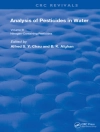Von drei weltbekannten Pharmazeuten herausgegeben, widmet sich dieser Band erstmals der ‘grünen’ Chemie im Umfeld der pharmazeutischen Industrie. Dabei geht es um einfache kleine Moleküle genauso wie um komplexe Proteine, um pharmazeutische Grundlagenforschung und um das Schicksal von Wirkstoffen in der Umwelt. Die handliche Monographie enthält zahlreiche bisher nicht publizierte Informationen, dazu überzeugende Fallstudien aus der Industrie (Taxol, Pregabalin, Crestor etc.), die zeigen, inwieweit ein multidisziplinärer Ansatz Effizienz und Umweltfreundlichkeit der Prozesse befördern kann. Ein abschließendes Kapitel befasst sich mit eindrucksvollen Technologien und technischen Hilfsmitteln.
Tabla de materias
INTRODUCTION TO GREEN CHEMISTRY, ORGANIC SYNTHESIS AND PHARMACEUTICALS
The Development of Organic Synthesis
The Environmental Factor
The Role of Catalysis
Green Chemistry: Benign by Design
Ibuprofen Manufacture
The Question of Solvents: Alternative Reaction Media
Biocatalysis: Green Chemistry Meets White Biotechnology
Conclusions and Prospects
GREEN CHEMISTRY METRICS
Introduction
Measuring Resource Usage
Life Cycle Assessment (LCA)
Measuring Chemistry and Process Efficiency
Measuring Process Parameters and Emissions
Real Time Analysis
Operational Efficiency
Measuring Energy
Measuring the Toxicity of All the Substrates
Measuring Degradation Potential
Measuring the Inherent Safety of Lack of Inherent Safety
Conclusions
SOLVENT USE AND WASTE ISSUES
Introduction to Solvent Use and Waste Issues
Solvent and Process Greenness Scoring and Selection Tools
Waste Minimization and Solvent Recovery
ENVIRONMENTAL AND REGULATORY ASPECTS
Historical Perspective
Pharmaceuticals in the Environment
Environmental Regulations
A Look to the Future
SYNTHESIS OF SITAGLIPTIN, THE ACTIVE INGREDIENT IN JANUVIA AND JANUMET
Introduction
First-Generation Route
Sitagliptin through Diastereoselective Hydrogenation of an Enamine. The PGA Enamine-Ester Route
The Triazole Fragment
Direct Preparation of Beta-Keto Amides
Second-Generation Chiral Auxiliary Route. The PGA Enamine-Amide Route
Prufication and Isolation of Sitagliptin (Pharmaceutical Form)
The Final Manufacturing Route
THE DEVELOPMENT OF SHORT, EFFICIENT, ECONOMIC, AND SUSTAINABLE CHEMOENZYMATIC PROCESSES FOR STATIN SIDE CHAINS
Introduction: Biocatalysis
The Relevance of Statins
Biocatalytic Routes to Statin Side Chains
2-Deoxy-D-Ribose 5-Phosphate Aldolase (DERA)-Based Routes to Statin Intermediates
Conclusions
THE TAXOL STORY-DEVELOPMENT OF A GREEN SYNTHESIS VIA PLANT CELL FERMENTATION
Introduction
Discovery and Early Development
From Extraction of Taxol from Pacific Yew Tree Bark to Semi-Synthetic Taxol
Taxol from Plant Cell Fermentation
Comparison of Semi-Synthetic versus PCF Taxol Processes: The Environmental Impact
Comparison of Semi-Synthetic versus PCF Taxol: Green Chemistry Principles
Final Words
THE DEVELOPMENT OF A GREEN, ENERGY EFFICIENT, CHEMOENZYMATIC MANUFACTURING PROCESS OF PREGABALIN
Introduction
Process Routes to Pregabalin
Biocatalytic Route to Pregabalin
Green Chemistry Considerations
Conclusions
GREEN PROCESSES FOR PEPTIDE MIMETIC DIABETIC DRUGS
Introduction
Green Chemistry Considerations in Peptide-like API manufacture
Purification Process to Manufacture Amorphous API
Preparation of Unnatural Amino Acids
Summary
THE DEVELOPMENT OF AN ENVIRONMENTALLY SUSTAINABLE PROCESS FOR RADAFAXINE
Introduction
Chemistry Process and the Dynamic Kinetic Resolution (DKR)
Multicolumn Chromatography – Development of Route 4
Environmental Assessment
Summary
CONTINUOUS PROCESSING IN THE PHARMACEUTICAL INDUSTRY
Introduction
Continuous Production of a Key Intermediate for Atorvastatin
Continuous Process to Prepare Celecoxib
Continuous Oxidation of Alcohols to Aldehydes
Continuous Production of Bromonitromethane
Continuous Production and Use of Diazomehtane
A Snapshot of Some Further Continuous Processes Used in the Preparation of Pharmaceutical Agents
Conclusions
PREPARATIVE AND INDUSTRIAL SCALE CHROMATOGRAPHY: GREEN AND INTEGRATED PROCESSES
Introduction
Basic Principles of Chromatography
Process Optimization to Reduce Eluent Consumption
Use of a Green Solvent: Supercritical Carbon Dioxide
Solvent Recycling Technologies
Application Examples
Conclusion: An Environmentally Friendly Solution for Each Separation
DYNAMIC RESOLUTION OF CHIRAL AMINE PHARMACEUTICALS: TURNING WASTE ISOMERS INTO USEFUL PRODUCT
Background
Integration of Chiral Amine Resolution and Racemization
Case Studies
Conclusions
GREEN TECHNOLOGIES IN THE GENERIC PHARMACEUTICAL INDUSTRY
Introduction
‘Waste’: Definition and Remedy
Amidation
Synthesis of Galanthamine
Synthesis of Solefinacin
Synthesis of Levetiracetam
Synthesis of a Finasteride
Sobre el autor
Peter Dunn received his Ph D from Imperial College London in 1987 working under the supervision of Professor Charles Rees. Postdoctoral work followed with Prof. Albert Eschenmoser at the ETH, Zurich and with Prof. Henry Rapaport at the University of California, Berkeley. In 1989 he joined Pfizer and was involved with the invention of the commercial processes to make several medicines including ‘Viagra’, Emselex, Revation and Sampatrilat. In 2000 he became Director of Chemical R & D at Pfizer and was responsible for the filing and transfer to manufacturing of human and animal medicines such as Voriconazole, Darifenacin, Fosfluconazole and Dirlotapide. In 2006 he took up his current role as Global Green Chemistry lead for Pfizer. He is currently co-chair of the Green Chemistry Institute Pharmaceutical Roundtable and a member of the editorial board for the journal of Green Chemistry.
Andrew Wells obtained his Ph D in organophosphorous and organometallic chemistry from Essex University, before joining the Chemical Development Group of Smith Kline & French in 1986, which later became Smith Kline Beecham. In 1999 he received a SKB corporate award for green chemistry/technology. In 2000, he joined Astra Zeneca in Global Process R & D where he is currently a Senior Principal Scientist and heads the AZ GPRD Green Chemistry group. He is an active member of the ACS Green Chemistry Institute Pharmaceutical Roundtable and has acted as an advisor to the UK Chemical Innovation Knowledge Transfer Network and the UK Technology Strategy Board. A keen supporter of the industry-academia interface, having been involved closely with several major collaborations such as the Centre for Biocatalysis at Manchester and the Institute of Process R & D at Leeds University, he has also been an industrial supervisor to around 20 Ph D and MSc students.
Michael Williams obtained his chemistry BSc from King’s College, London, and spent time as a medicinal chemist at ICI Pharmaceuticals (Alderley Park), before obtaining his Ph D working with Professor Charles Rees at the University of Liverpool. He joined the Chemical R & D department at Pfizer at Sandwich in 1972, where his career responsibilities included the Medicinal Chemistry/Development interface, and technology adoption. In addition to his experience with approximately 50 early drug candidates, he played a significant role in the late development, filing and commercializing of many agents including Zoloft, Viagra and Relpax. He became Executive Director and Departmental Head of UK Chemical R & D in 2003, leading a significant growth to 117 laboratory staff, and helping to build a 40 strong Material Sciences group. Since retiring from Pfizer in 2007, he has been an independent consultant, in addition to his work in editing and scientific writing.












